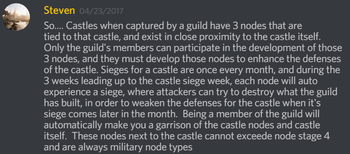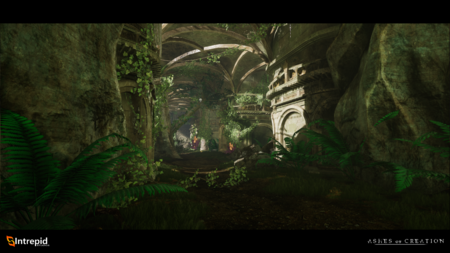Node-Standorte
Zum Launch wird es 85 normale Node-Standorte geben, zuzüglich 15 weiterer Burgen-Nodes (5 Burgen x je 3 Burgen-Nodes)[1][2][3], was insgesamt 100 Nodes ergibt.[4]
- Zuvor war von 103 Node-Standorten die Rede, zuzüglich 15 Burgen-Nodes, was insgesamt 118 Nodes entspricht.[5][6][1][2][3]
- Die Reduzierung der verfügbaren Nodes wird keinen Einfluss auf die Menge der verfügbaren Spielerbehausungen, oder die angestrebte Serverkapazität haben.[7][8]
- Wir sind von 103 Nodes auf 85 Nodes umgestiegen; Und dafür gibt es einige Gründe. Erstens: Als wir die Berechnungen anstellten, wie diese Vasallenstrukturen in Alpha 2 und im Spiel existieren sollen, hatten wir mehr Nodes, als uns sinnvoll erschienen, und wir wollten einige dieser kuratierten Handlungsstränge und -haken zu einer Zusammenfassung zusammenfassen Die Umgebung und das Reich um die Gebiete herum sollen bei einem geringeren Nodes üppiger sein: Das bedeutet, dass wir die Anzahl der Nodes verringern, damit wir den Reichtum jedes dieser Nodes mehr als bei 103 erhöhen können.[4] – Steven Sharif
- In der Alpha-1 gab es 9 Node-Standorte.[9]
- Node-Standorte können sich bis zur Beta-1 ändern.[9]
List of nodes
Adaptive Inhalte
Neue Points of Interest (wie z.B. Dungeon und World Bosse) spawnen, wenn sich Nodes entwicklen.[10] Dieser Content passt sich an die Entwicklung der Zone an, in der er sich befindet.[11]
- Die Population wird sich verändern.[11]
- Die Schwierigkeit des Contents wird sich ändern.[11]
- Der Content ändert sich vielleicht Grundlegend, abhängig davon, was sich wie entwickelt.[11]
- Verschiedene Arten von Antagonisten mit verschiedenen Storylines.[11]
- Manche Dungeons werden nur freigeschaltet, wenn sich Nodes zu einer bestimmten Stufe entwickeln.[12]
- Die Ziele einer Storyline innerhalb von Dungeons hängen davon ab, welche Story Arcs durch das Node System gewählt wurden.[12]
- Drop Tables in Gebieten und Dungeons werden in die Fortschritt von bestimmten Gebieten eingebunden sein.[12]
Certain dungeons and other points of interest across the map will all be affected by the server’s node development. Some dungeons will only be unlocked if nodes are developed to certain stages. The storyline objectives for players inside dungeons will also be dependent on the story arc paths chosen through the node system. The drop tables in area and dungeons will also be tied into the progression of certain areas. For example, let’s say that the humans have developed a node in Region A, and a storyline has opened up that leads players to inspect the ruins (dungeon) of a nearby area. And let’s say that this node was developed in a scientific (crafting) zone… Well before the node developed, this dungeon was accessible… But now the dungeon has propagated new monster assets that include a drop table catering to a crafting emphasis because of the development of that academic node. And perhaps, a new boss appears in different rooms of the dungeon that includes different adventure quest starts, like a mysterious item with a storyline that can only be progressed if a node develops to the metropolis stage in a certain region, across the world. Our system is so vast, when it comes to interconnectivity and how the world reacts to the players.[12]
Siehe auch
Einzelnachweise
- ↑ 1.0 1.1 Blog: 10 facts about castle sieges in the MMORPG.
- ↑ 2.0 2.1

- ↑ 3.0 3.1 Podcast, 2018-04-23 (15:14).
- ↑ 4.0 4.1 Liveübertragung, 2022-08-26 (1:05:47).
- ↑ Blog - Know Your Nodes - The Basics.
- ↑ Interview, 2018-08-24 (3:44).
- ↑ Liveübertragung, 2022-08-26 (1:18:54).
- ↑ Liveübertragung, 2022-08-26 (1:06:42).
- ↑ 9.0 9.1 Liveübertragung, 2020-11-30 (37:16).
- ↑ Liveübertragung, 2017-11-17 (36:22).
- ↑ 11.0 11.1 11.2 11.3 11.4 Liveübertragung, 2017-11-17 (18:29).
- ↑ 12.0 12.1 12.2 12.3 MMOGames interview, January 2017
